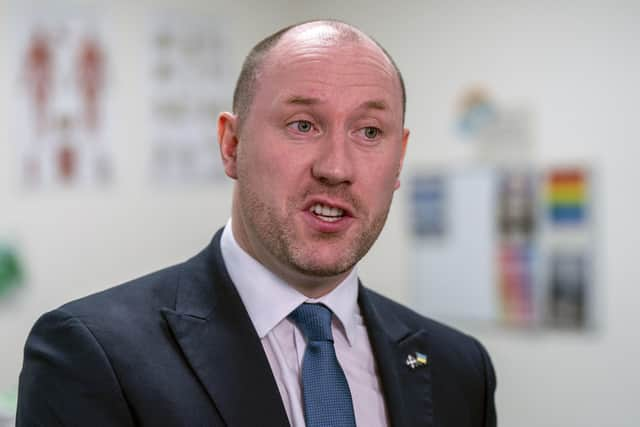NHS Scotland: After the winter, why is Scotland's healthcare system still feeling the pressure?
Pressure on the NHS is now being sustained over the spring and summer, figures show, with claims Scotland is “simply lacking the workforce it needs” to sustain the healthcare service.
Indicators of pressure on Scotland’s healthcare system, such as A&E waiting times, delayed discharge times and treatment waiting lists, usually swell over the winter months - as seasonal viruses and weather-related accidents take their toll, particularly on more vulnerable people. However, this demand has been sustained.
Advertisement
Hide AdAdvertisement
Hide AdPost-pandemic, there was a rapid rise in the pressure being exerted on hospitals, GP surgeries and A&E departments that far surpassed the pre-pandemic period.


This was in large part due to the enormous backlogs built up during the pandemic, and patients who had postponed seeking treatment during lockdown were now presenting at GP practices and A&E departments with much more acute illnesses.
But with the health consequences of the pandemic now fading, why is Scotland’s NHS still facing immense pressure year-round?
On Sunday, Scotland on Sunday revealed how nearly 25,000 NHS Scotland operations have been cancelled with short notice over the last year, with the British Medical Association (BMA) saying the health service is experiencing “a medical workforce crisis”.
From March 2023 to February 2024, 24,802 of the 280,298 planned operations in Scotland were cancelled on the day of the surgery, or the day before – equivalent to 8.8 per cent.


This means one in twelve Scots awaiting surgery have had their procedure postponed with short notice.
In emergency departments, the new Scottish health secretary Neil Gray said in February that NHS Scotland’s A&Es are showing “signs of stabilisation” and that pressure should ease “in coming weeks”.
Since the summer months of 2020, Scotland’s A&E performance, when measured by the percentage of patients waiting more than four hours to be seen, has trended downwards, although recently the performance has remained steady, as Mr Gray said.
Advertisement
Hide AdAdvertisement
Hide AdThe coming easement has not been apparent, however, with the latest A&E statistics showing just 65.4 per cent of Scottish patients are seen within four hours.
The Scottish Conservative shadow health secretary, Dr Sandesh Gulhane, has accused the Scottish Government of presiding over a “permanent crisis” in Scotland’s A&Es, after figures showed a rise in the number of patients suffering the longest waits.
In the week ending March 24, one in 20 patients (5 per cent) in A&E took more than 12 hours to be either admitted, transferred or discharged – with 1,344 people waiting that long.
Figures show that of the 26,867 people who went to A&E for help, 65.4 per cent were admitted, transferred or discharged within the four hour target time.
Dr Gulhane, who is also a GP, added that the Government’s “dire workforce planning and Humza Yousaf’s flimsy Covid recovery plan mean that patients and staff have had to endure the worst ever waiting times to ever occur on record in a February”.
He said that Health Secretary Neil Gray had “inherited a mess from his disgraced predecessor Michael Matheson”, and added that Mr Gray had “failed to act on spiralling waiting times since taking up his new job”.
Mr Gray said: “We know that the health service remains under sustained pressure. Waiting times are longer than we want them to be for too many patients, and we continue to work with boards to reduce these instances.
“Despite this, the monthly statistics show an improvement in A&E performance.”
Advertisement
Hide AdAdvertisement
Hide AdThe Health Secretary continued: “The pressures being felt by our A&E departments are not unique to Scotland, with similar challenges being felt by emergency departments throughout the UK and beyond.
“A&E performance is impacted by pressures from across the wider health and social care system, which is why our Unscheduled Care Collaborative Programme is taking a whole system approach as we work with health boards to deliver sustained improvement.”
The problem, according to Scotland’s healthcare unions, is the workforce - namely recruitment and retention.
Colin Poolman, the Royal College of Nursing’s Scotland Director, said pressures in Scotland’s health and care systems “have not let up over the summer”. The system is under huge amounts of sustained pressure all year round and action to tackle this must focus on addressing workforce shortages in a sustainable way.
“Scotland simply doesn’t have the nursing workforce it needs and action to tackle this workforce crisis has, so far, not been sufficient.”
Mr Poolman added that the Scottish Government “must provide the investment, and the political will, needed to ensure the taskforce delivers meaningful change”.
Overworked and underpaid staff are increasingly leaving NHS Scotland, either through early retirement or leaving the health sector completely, and the Scottish Government is struggling to attract students to medicine due to the working conditions of the career.
This has led to a workforce shortage, which is manifesting in different ways.
Advertisement
Hide AdAdvertisement
Hide AdFirstly, there is an immense Covid backlog to work through, which requires serious resources to tackle.
Secondly, a lack of staff is causing congestion at each stage of a patient’s journey through Scotland’s hospitals. There are limited care placements due to staffing shortages, so vulnerable patients cannot be discharged from wards. Care workers can earn more, and work in a much less demanding environment, such as in supermarkets, and are leaving in their droves.
The hospital wards themselves are staffed by a minimal number of exhausted, overworked and, in their opinion, underpaid staff. There are around 5,000 nursing vacancies in Scotland. The vulnerable patients who are fit enough to leave have nowhere to go.
The pressure in hospital wards is in turn causing congestion in A&E, where patients cannot be admitted to hospital beds that do not exist. Here too, staff are burned out and looking for the exit.
Simon Barker, deputy chair of the BMA's Scottish Council, said: “It’s frankly shocking that what used to be seen as winter pressures are now simply a daily reality with undignified care of patients in corridors now becoming normal. Regrettably the NHS in Scotland is increasingly an emergency and cancer only service."
Comments
Want to join the conversation? Please or to comment on this article.